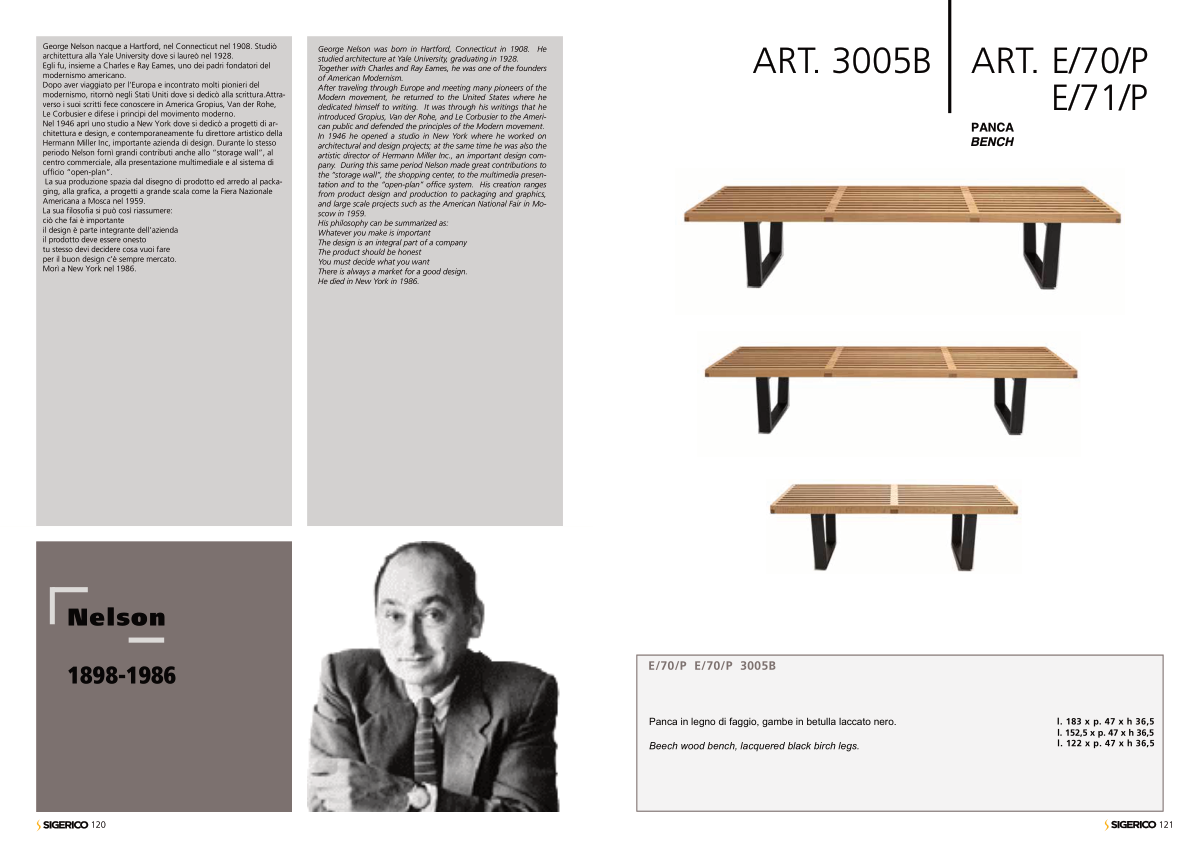Nelson
1898-1986
George Nelson nacque a Hartford, nel Connecticut nel 1908. Studiò
architettura alla Yale University dove si laureò nel 1928.
Egli fu, insieme a Charles e Ray Eames, uno dei padri fondatori del
modernismo americano.
Dopo aver viaggiato per l’Europa e incontrato molti pionieri del
modernismo, ritornò negli Stati Uniti dove si dedicò alla scrittura.Attra-
verso i suoi scritti fece conoscere in America Gropius, Van der Rohe,
Le Corbusier e difese i principi del movimento moderno.
Nel 1946 aprì uno studio a New York dove si dedicò a progetti di ar-
chitettura e design, e contemporaneamente fu direttore artistico della
Hermann Miller Inc, importante azienda di design. Durante lo stesso
periodo Nelson fornì grandi contributi anche allo “storage wall”, al
centro commerciale, alla presentazione multimediale e al sistema di
ufficio “open-plan”.
La sua produzione spazia dal disegno di prodotto ed arredo al packa-
ging, alla grafica, a progetti a grande scala come la Fiera Nazionale
Americana a Mosca nel 1959.
La sua filosofia si può così riassumere:
ciò che fai è importante
il design è parte integrante dell’azienda
il prodotto deve essere onesto
tu stesso devi decidere cosa vuoi fare
per il buon design c’è sempre mercato.
Morì a New York nel 1986.
George Nelson was born in Hartford, Connecticut in 1908. He
studied architecture at Yale University, graduating in 1928.
Together with Charles and Ray Eames, he was one of the founders
of American Modernism.
After traveling through Europe and meeting many pioneers of the
Modern movement, he returned to the United States where he
dedicated himself to writing. It was through his writings that he
introduced Gropius, Van der Rohe, and Le Corbusier to the Ameri-
can public and defended the principles of the Modern movement.
In 1946 he opened a studio in New York where he worked on
architectural and design projects; at the same time he was also the
artistic director of Hermann Miller Inc., an important design com-
pany. During this same period Nelson made great contributions to
the “storage wall”, the shopping center, to the multimedia presen-
tation and to the “open-plan” office system. His creation ranges
from product design and production to packaging and graphics,
and large scale projects such as the American National Fair in Mo-
scow in 1959.
His philosophy can be summarized as:
Whatever you make is important
The design is an integral part of a company
The product should be honest
You must decide what you want
There is always a market for a good design.
He died in New York in 1986.
ART. E/70/P
PANCA
BENCH
E/71/P
l. 183 x p. 47 x h 36,5
l. 122 x p. 47 x h 36,5
121
120
l. 152,5 x p. 47 x h 36,5
ART. 3005B
Panca in legno di faggio, gambe in betulla laccato nero.
Beech wood bench, lacquered black birch legs.
E/70/P E/70/P 3005B


